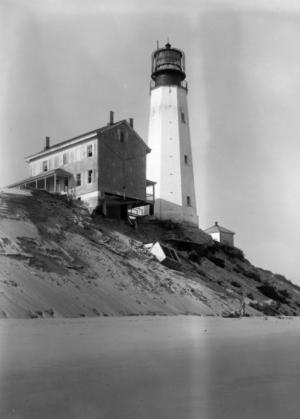24 JULY 1919 REPORT
Lewes, Delaware 22 July 1919:
The Atlantic seas have crept 150 feet towards the 1764 structure the past eight years according to records kept by chief keeper H. H. Palmer, changing the sand dune base. There are some who call for saving the light and there are some who call for its removal. The light tower would need to be moved inland at least one mile to be safe.
The Cape Henlopen Light's history date to before the American Revolution with stone brought from England, and is 135 feet high from sea level, standing on a great dune two and a half mile long and a half mile wide and 87 feet high. Today, sand is being hauled away by railroad cars to be sold to contractors. When built the light could not be seen from Lewes but nature has changed that so today the lighthouse tower and keepers house is plainly seen from the town's center. The tall pine which hid the light has been covered over by the sand dune. At one time it was thought the ' Hen and Chicken Shoals ' would protect the dune but that is not happening.
The Cape May Light, 14 miles away to the north, is its competitor.
Inside the tower is a winding stairway with a landing every 30 feet reaching the ' lens ' made in France and England and are enormous and covered by red shades for sun protection. The light from this lens can be seen 30 miles at sea. Kerosene oil is used to produce the light which is stationary requiring constant attention to keep it from ' going out’.
As of this date, a new Government wireless radio station of 9 men is nearby with sleeping and eating space and a new experiment being conducted on locating the exact compass position of a ship in distress by the three Coast Guard Stations.
Abstract: Wilmington Morning News, Thursday, July 24, 1919























































